An outbound sales process is a system that efficiently and successfully guides prospects through the whole customer journey using accessible resources to make that journey pleasant for those prospects. A good outbound sales process is probable and repeatable. An excellent sales process is scalable.
Though, the whole outbound sales process is full of challenges that, if mistreated, can weaken not just the productivity of a sales rep, but an entire business. But different tools can do magic for automating the whole outbound process.
In order to build an excellent practice, you need to consider your buyer’s journey and find the most significant pieces for each stage of the journey.
There are Four Main Stages of Outbound Sales Process that Holds it Together
- Lead Generation
- Lead Management
- Demonstrating the product
- Closing the Deal
For each phase, figure out what needs to be done in order to efficiently move the prospects into the next phase.
Let’s walk through the outbound sales process and tools that will fit better in each stage of the process.
Stage 1 — Outbound Lead Generation
There are three main ways to approach lead generation:
- Manual prospecting
- Third party lead sourcing
- Hiring independent freelancer
When it comes to manual prospecting (lead generation), hustling matters. You need to know your business finances, to know which plan suits you better and how long it takes to discover one qualified lead? Then, consider sales intelligence software which can provide sales reps with dynamic evidence, like background and contact information, for a leads, accounts, or across market verticals.
LinkedIn Sales Navigator is a good tool to kick things off because most of the B2B prospects hang out on LinkedIn. This tool can give necessary information very quickly.
Some businesses don’t have the time, capitals or pricing policy to validate manual prospecting, in that case, they can hire a 3rd party lead sourcing company. This is a flexible option because you can customize your order depending on your needs.
Rather than paying with time, you’re paying with currency. There’s one more viable option for lead generation: Hiring independent freelancer. Elance and Upwork are two good places for hiring freelancer.
But handling a team of freelancers comes with its own dares, and deserve a blog post all its own.
Essential questions to ask when selecting tools/platforms in the Lead Generation stage contain:
- How precise is the data (data reliability)?
- How much information is given against each lead?
- What is price per lead and does that work with my business finances?
Recommended Tools: Sales Intelligence
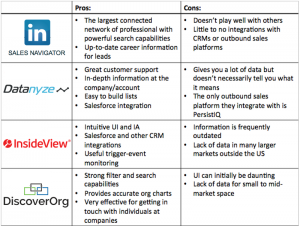
Lead Sourcing
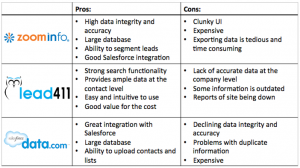
Stage 2 — Lead Management
In concept, CRM was made for lead management. Often time, CRM can slow down a high-speed sales process, particularly at the top of the pipe where the majority of the data is. This has led to a tool focused particularly on the outbound processes.
That doesn’t mean the CRM has no purpose. It should be the support of the sales practice, the core record for all communication and hub for organizing the activities of sales and marketing teams. Therefore, your outbound sales process has to be suitable with your CRM platform.
In a dynamic sales process, the amount of outbound sales work is vast (email, phone, social media, direct mail, etc.). Few platforms can handle the challenge of handling that much while keeping the personal human element of sales, at the same time avoiding leads from dipping through the cracks.
In most cases, it takes multiple tries to get a reply from a lead. There are many issues in making an effective outbound sales campaign, and your outbound sales platform have to be on support. Research shows best performing campaigns have been those that are very personalized. There’s a fine line between automation and personalization!
Question to ask when picking your platform for Lead Management purpose:
- Am I using the right tool for my outbound sales, or am I planning to create a sales resolution using marketing automation?
- Can my CRM platform fit in with my outbound sales automation?
- Can I simply import and develop leads pipeline with the system?
- Can I check and examine multiple messages with multiple campaigns?
- How efficiently can I work together with my team on each platform?
Recommended Tools: CRM
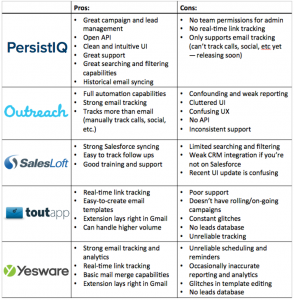
Outbound Sales Platform: Email Marketing & Management
Stage 3 — Demonstrating the Product

When things are going fine and a decent proportion of the cold email is converted to outbound call, demos and in-person meetings, organizing the calendar can become difficult. It shouldn’t take numerous emails with a likely client to pin down a time to talk.
There are few good tools that integrate well with Google Apps, which let you propose a variety of possible meeting times for prospects to choose from and avoid double booking meetings.
Demo and Screen sharing tools have been upgraded a lot. The technology wasn’t as responsive before, but with cloud solutions, this problem isn’t in the picture. A chaotic screen share can kill a good presentation.
UberConference and Join.me are two good platforms for such tasks.
Questions to ask when selecting your tools/platforms in this demo stage:
- Does the scheduling technology integrate with calendar?
- How consistent is the service?
- How rapidly and effortlessly can the other party access the meeting?
Recommended Tools: Scheduling
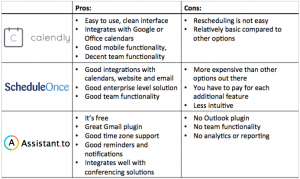
Conferencing
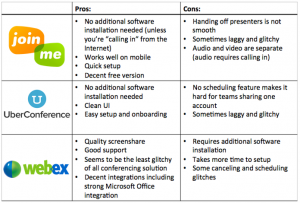
Stage 4 — Seal the deal

After giving the demo, it’s time to seal the deal. Tools that can lessen the resistance of the buying process, like DocuSign or HelloSign for e-signatures.
But just like the cold emailing stage, research and determination are key. You have to be sure if you are talking to a decision maker or not? How much authority that person has?
Most of the time sales stop advancing after the demo. It’s because the sales executives stop pushing forward, or worse, has failed to precisely map the account and is forcing it down the wrong track. Sadly, we have yet to discover a tool that can do that job for us.
Necessary questions to ask when choosing your tools in the closing deal stage:
- How easy and smooth is it to build a pitch?
- How safe is the service?
- How intuitive is it to edit templates and schemes?
- How much automation do you need in the procedure?
Recommended Tools: Contracts
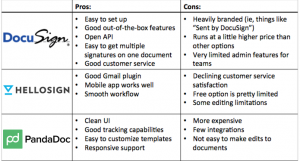
Over to You
Creating the right combination for your outbound sales team is a matter of plotting out your buyer’s journey and finding your team’s needs to move prospects through that buyer’s journey efficiently.It is like a a cup of coffee.
The bottom line is you should never devote in a tool or platform within your sales pile that does not undoubtedly fit into your process and improve outbound sales skills of reps.
Use data to guide results. Do a minute-by-minute workflow analysis so that you can recognize where your blockages are and how to simplify the process.
